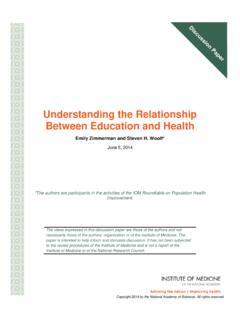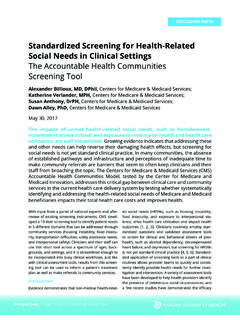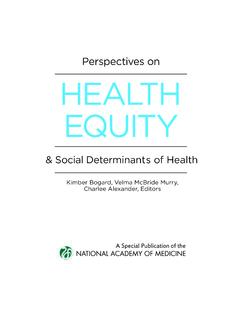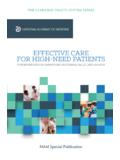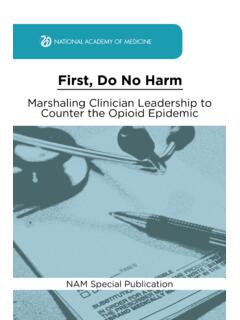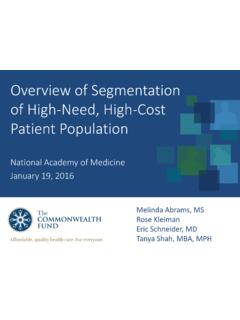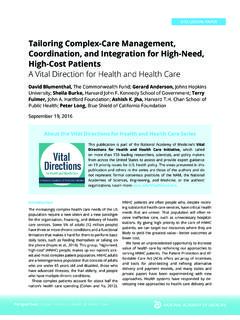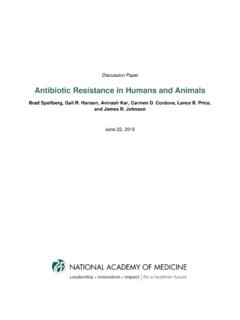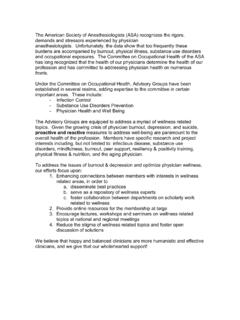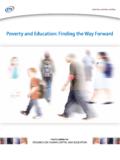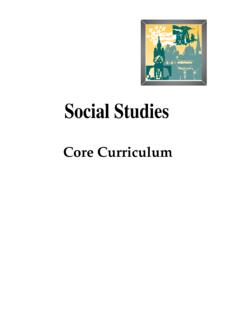Transcription of Understanding the Relationship Between Education and …
1 Understanding the Relationship Between Education and health Emily Zimmerman and Steven H. Woolf*. June 5, 2014. *The authors are participants in the activities of the IOM Roundtable on Population health Improvement. The views expressed in this discussion paper are those of the authors and not necessarily those of the authors' organization or of the Institute of Medicine. The paper is intended to help inform and stimulate discussion. It has not been subjected to the review procedures of the Institute of Medicine and is not a report of the Institute of Medicine or of the National Research Council. Copyright 2014 by the National Academy of Sciences. All rights reserved. Understanding the Relationship Between Education and health Emily Zimmerman and Steven H. Woolf, Virginia Commonwealth University1, 2. It is now widely recognized that health outcomes are deeply influenced by a variety of social factors outside of health care.
2 The dramatic differences in morbidity, mortality, and risk factors that researchers have documented within and Between countries are patterned after classic social determinants of health , such as Education and income (Link and Phelan, 1995; CSDH, 2008), as well as placed-based characteristics of the physical and social environment in which people live and the macrostructural policies that shape them. A 2013 report from the National Research Council and the Institute of Medicine cited these socioecological factors, along with unhealthy behaviors and deficiencies in the health care system, as leading explanations for the health disadvantage of the United States. In a comparison of 17 high-income countries, age-adjusted all-cause mortality rates for 2008 ranged from per 100,000 in Australia to in the United States. The report found a pervasive pattern of health disadvantages across diverse categories of illness and injury that existed across age groups, sexes, racial and ethnic groups, and social classes (NRC and IOM, 2013).
3 Recent attention has focused on the substantial health disparities that exist within the United States, where life expectancy varies at the state level by years for males and years for females (NRC and IOM, 2013) but mortality and life expectancy vary even more substantially across smaller geographic areas such as counties (University of Wisconsin Population health Institute, 2013; Kulkarni et al., 2011) and census tracts. In many cities, life expectancy can vary by as much as 25 years across neighborhoods (Evans et al., 2012). The same dramatic geographic disparities can be seen for other outcomes, such as infant mortality, obesity, and the prevalence of diabetes and other chronic diseases. Of the various social determinants of health that explain health disparities by geography or demographic characteristics ( , age, gender, race-ethnicity), the literature has always pointed prominently to Education .
4 Research based on decades of experience in the developing world has identified educational status (especially of the mother) as a major predictor of health outcomes, and economic trends in the industrialized world have intensified the Relationship Between Education and health . In the United States, the gradient in health outcomes by educational attainment has steepened over the last four decades (Goldman and Smith, 2011; Olshansky et al., 2012) in all regions of the United States (Montez and Berkman, 2014), producing a larger gap in health status Between Americans with high and low Education . Among white Americans without a high school diploma, especially women, life expectancy has decreased since the 1990s, 1. The authors are participants in the activities of the IOM Roundtable on Population health Improvement. 2. Suggested citation: Zimmerman, E., and S.
5 H. Woolf. 2014. Understanding the Relationship Between Education and health . Discussion Paper, Institute of Medicine, Washington, DC. 1. whereas it has increased for others (Olshansky et al., 2012). Death rates are declining among the most educated Americans, accompanied by steady or increasing death rates among the least educated (Jemal et al., 2008). What accounts for the growing health advantages that exist among people with higher educational attainment? Is it what they learn in school, such as how to live a healthy lifestyle, or the socioeconomic advantages that come from an Education ? Or is the cross-sectional association Between Education and health more complex, involving numerous contextual covariables that provide a fuller back story? Despite decades of research documenting the connections Between Education and health , there is still much to learn about the mechanisms that enable this connection.
6 Unpacking the reasons for the connections Between Education and health is not just an exercise in scientific inquiry; it is also essential to setting policy priorities. As increasing attention is focused on the need to address social inequity in order to address health inequities, Understanding the links Between broad upstream factors such as Education and health outcomes becomes a critical challenge. Awareness of the importance of Education might help drive investment in Education and improvements in educational policy. CONCEPTUAL FRAMEWORK. An overarching theoretical framework for the impact of social determinants on health is provided by an ecological model in which individuals and their behaviors are embedded, across the lifespan, within a framework of nested institutional contexts (IOM, 2000;. see Figure 1). The individual and his or her characteristics are situated within and affected by the family and household, the community and its institutions ( , school, workplace, and civil Figure 1: Socioecological Model institutions), and policies of the larger society.
7 Each level brings access to opportunities, as well as constraints on actions and opportunities. Furthermore, these levels interact with one another, such that family resources, for example, may mediate or moderate the resources available within the community. social scientists widely agree that unequal social status creates unequal access to resources and rewards. social structure, as embodied in social position, structures individual behaviors and values and therefore affects many of the mediators in the Relationship Between Education and health . Education is one of the key filtering mechanisms that situate individuals within particular ecological contexts. Education is a driving force at each ecological level, from our choice of partner to our social position in the status hierarchy. The ecological model can therefore provide a context for the numerous ways in which Education is linked to our life experiences, including health outcomes.
8 It also provides a framework for Understanding the ways in which educational 2. outcomes themselves are conditioned on the many social and environmental contexts in which we live and how these, in turn, interact with our individual endowments and experiences. Within this rich contextual framework, educational attainment (the number of years of schooling completed) is important but is far from the whole story. Educational attainment is often a key indicator in research studies, not least because it is often measured and recorded; life expectancy is compared by educational attainment because it is the only information about Education recorded on death certificates. Besides such obvious measures of the quality of Education as proficiency scores and Understanding of mathematics, reading, science, and other core content, other dimensions of Education are clearly important in the ecological context as well; cognitive development, character development, knowledge, critical thinking and problem solving are a few examples.
9 In addition, the Relationship Between years of Education and health is not a purely linear function. As part of the literature attempting to clarify the functional form of the Relationship Between Education and health , Montez et al. (2012) have documented a negative Relationship Between years of Education and mortality risk for attainment less than high school graduation, a steep decline for high school graduates (with reduction of risk five times greater than attributable to other years of Education ), and a continued yet steeper negative Relationship for additional years of schooling. The drop at high school graduation points to the importance of obtaining credentials in addition to the other benefits associated with educational attainment. In this paper we review the health benefits associated with Education , focusing on the primary mechanisms, both distal and proximate, by which Education may be considered a driving force in health outcomes.
10 We take a socioecological approach by presenting these concepts in a hierarchy, moving from the level of the person to the community/institution and then the larger social /policy context. Next, we turn to issues of causality that can make it difficult to draw conclusions about the Relationship Between Education and health . These include reverse causality and selection, in which Education may be impacted by ill health , and confounding, where both Education and health are affected by some other causal factor(s) that may also provide important clues about the root causes of poor Education and poor health . THE health BENEFITS ASSOCIATED WITH Education . Among the most obvious explanations for the association Between Education and health is that Education itself produces benefits that later predispose the recipient to better health outcomes. We may think of these returns from Education , such as higher earnings, as subsequent downstream benefits of Education .
